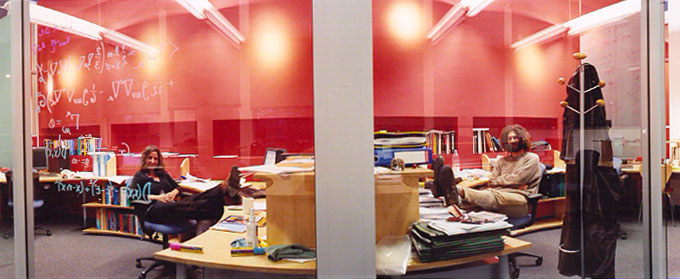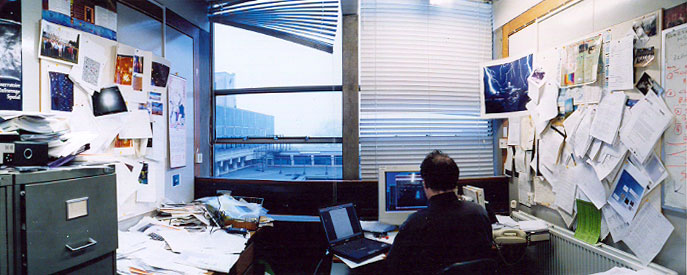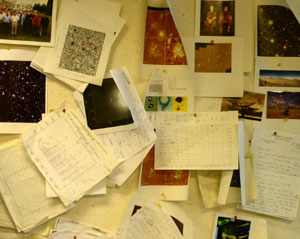December 19, 2003
How to make a million . . .
In Clerkenwell yesterday I chanced upon a gallery whose name I shall not mention (save that it includes the word gallery and the word blue). Through the windows I spied beautiful images of galaxies and planets and intrigued went in to take a look. 22 high quality prints mounted on aluminium, being sold in editions of 12 for at least a grand. Work that out.
There was something very familiar about a lot of the images and reading the blurb next to each one it was obvious why - they nearly all came from the Hubble telescope.
Now this struck me as odd. I've visited the Hubble site and I know one can download the images in a variety of file sizes from a few k to massive 250 mb hi res. So how come someone is selling them ?
I asked the gallery man and he explained that they're public domain - so anyone can do it. He then added sheepishly, that it took a lot of skill - because there are so many and you need a good eye to pick out the beautiful ones.
What a load of toss ! What a way to make a quick buck.
December 17, 2003
What do I know ?
What do I know ? Not a lot. My head is full of phlegm and aching from the trials of negotiating the transport system between London and Oxford. Nothing new there, but compounded by stumbling onto a northbound - rather than southbound - Bakerloo line train. Lack of concentration. Of course I should have been on the Circle line but that was broken, as per usual.
Sometimes I wonder what I really need to know. Today I took my photos into the department and people were very positive and enthusiastic about them which is nice. I suppose they are the first sign that I do more than just poke around asking questions, that I produce something approximating art. So in a sense I could spend my time taking photos and pass myself off as an artist in residence without really knowing a lot about Astrophysics.
But that would be missing the point. There is something really fascinating about the offices and the people in them. They all have very distinct personalities - the offices and the people - and the light is often very beautiful. So a degree of understanding what the people are interested in, working on etc helps to get the best results. And that involves talking to people.
The point is though that I want to know about Astrophysics, to understand it. It's inspiring and a lot of it is pretty way out. There's a part of me that seems to need to understand how things work and you can't get much bigger than the workings of the universe - or smaller than quantum mechanics. This is where they meet so I'm in the right place. That's why I wanted to come here.
It's tough though. Today I went to a lecture and really it was a bit above my head. So much maths. So do I learn the maths ? Do I need to ? Probably not but I'd like to and feel a certain compulsion to. I get the impression that there are some things you can only really understand through the maths.
So it's nearly christmas and everyones off to their parts of the world for a few weeks, term is over. It's been really enjoyable and the people have been very warm and welcoming. A good time to piece together what I know. When the phlegm goes it'll be a lot easier.
Jannas off to NYC to live and work and we never got to build the little universes.
December 10, 2003
The Sound of a Drum
It should be possible to reconstruct the shape, size and make up of an object by studying how sound propagates in it. We use the word “sound” quite loosely to mean vibrations, or wave-like signals. For example if we have a block of material and we knock it, it should tremble and shake for a bit before it settles down and becomes still. It settles down because the energy we impart it, and sets it vibrating, slowly dissipates and heats the block up. Let us now consider a simple, two dimensional, surface: the surface of a drum. The edges are securely fastened to a rim which can have any size or shape. We are used to round drums, but there are oval drums or even square ones. If we bang the drum, the membrane will vibrate and emit sound. The sound we hear is simply the motion that the vibration of the membrane imparts on the air around it. We could, for example, put a pencil between our teeth and hold it to the rim. Our head would pick up the vibrations and we would hear the sound of the drum.
The sound that each drum makes depends on a number of things. It depends on its size for example. The smaller the drum, the higher the pitch it emits because the quicker it vibrates and the shorter the size of the vibrations. It will also depend on its shape. For example, a circular drum is symmetric in that it we can turn it round its centre by any amount, and it always looks the same. This severely restricts the type of sound it can make. A square drum also has some symmetry. We can turn it around by 90 degrees and it will look unchanged. But we can’t rotate it by an arbitrary amount, unlike the circular drum. The types of vibrations that these two drums can host are different. Finally, the constitution of the membrane will greatly affect what it sounds like. If it is thick and tightly stretched it will tremble more quickly than if it is thin and flaccid. So by listening to its sound, we can figure out what a drum looks like and what it is made of. Of course it is never that simple because the different properties (shape, size and constitution) may affect the sound in similar ways and it becomes difficult to disentangle what is responsible for making the drum sound the way it does. For example a small, loosely stretched may sound vaguely similar to a large, taut one. They won’t sound exactly the same, and the more precise our hearing, the more accurately we can distinguish between them.
Panoramic photos & wormholes
I'm not happy with the digital photos I've been taking in the offices. Fine for details but they fail to capture the complete picture. Today I've been using a quirky "Horizon" camera, one with a lens that sweeps a panoramic arc of 120 degrees. I revisited SR in his office and took a series there which capture the whole room - wall to window to wall. Then downstairs in the new office I took some more, some of Janna in her office and some of her and CS. The offices here are open plan in that their walls are glass looking out into the rest of the space. Janna and CS are in adjacent rooms. From the outside one can see them working away, facing each other - but they can't see each other as the wall between them is solid and opaque.


On the train I read about white holes, the opposite of black holes. That's a new one on me ! . . . and how you can - theoretically - cut and paste a black hole and white hole together into two different spaces and creatre a time warp, a wormhole. In trying to understand this it all started to unravel into theories of different spacetimes, Schwarzschild geometry, light cones, relativity . . . I found some interesting websites : Orbits in strongly curved spacetime (spirograph esque particle orbiting black hole), Fantasy movies of trips to neutron stars and black holes and white holes and wormholes.
I compiled a cd of songs for the band to draw initial material from and tracked down LC who I'd heard was a drummer and spent a while talking to him about his work weighing our galaxy and long nights spent in observatories, and about music.
Now we have guitars, banjo, cello, vocals and drums and will start to rehearse in January.
I've been re reading Jannas book, "How the Universe Got It's Spots", in particular in relation to the CMB and the idea of the universe as a resonant space, as a drum. I talked to her to try and clarify my understanding and to see if my ideas of interpreting the data made sense. She reckoned that I'd just get white noise if I took the full spectrum of data and that it would be better to concentrate on certain dominant frequencies - or to start the other way round - to work up from the idea of simple geometric spaces and explore their resonance.
Song List
Galaxy in Turia - Alice Coltrane | Blackhole - Beck | Girlfriend Stole my Alien - Jem Finer & The Big Shit Orchestra | Flying Saucers Rock n Roll - Billy Lee Riley & his Little Green Men | I'm the Urban Spaceman - Bonzo Dog Doo Dah Band | Man from Mars - Butch Paulson | Mr Spaceman - The Byrds | Big Eyed Beans from Venus - Captain Beeheart | Shootin for the Moon - Carl & Norman | Bad Moon Rising - Credence Clearwater Revival | Space Oddity - David Bowie | Starman - David Bowie | Hallo Spaceboy - David Bowie | The Boppin Martian - Dick Robinson | Flying Saucer Boogie - Eddie Cleo & his Round Up Boys | Fly Me to the Moon - Frank Sinatra | First Man on Mars - Jackie Fantheree | Rocket Trip - Jackie Lowell | Rocket in my Pocket - Jimmy Lloyd | Rock on the Moon - Jimmy Stewart | Northern Star - Leona Naess | Satellite of Love - Lou Reed | Rock Old Sputnik - Nelson Young | Champagne Supernova - Oasis | Another Girl, Another Planet - The Only Ones | Satellite Fever, Asiatic Flu | Interstellar Overdrive - Pink Floyd | Cirrus Minor - Pink Floyd | Blue Moon of Kentucky - Elvis Presley | Planet Telex - Radiohead | Black Star - Radiohead | Sputnicks & Mutnicks - Ray Anderson & the Homefolks | Cygnus X-1 - Rush | Satellite Baby - Skip Stanley | Walking on the Sun - Smashmouth | Creature from Outer Space - Sonny Day | Orbit with Me - Sonny Sheather | Black Hole Sun - Soundgarden | Space is the Place - Sun Ra | Rocket Number 9 - Sun Ra | Rock on Mars - Terry Donovan | Telstar - The Tornadoes | Venus in Furs - The Velvet Underground | Island in the Sun - Weezer | Cygnus X-1 - Weezer | I'm Building a xxx on the Moon - Weldon Rogers | Trip to the Moon - Wesley Reynolds | Martian Band - The Wildtones
December 1, 2003
Dark Energy
In the past seven years, there have been a number of measurements that seem to indicate that the universe is full of a very strange form of invisible energy. It is invisible because it doesn’t emit, or interact with light. In this sense it is very much like the famous dark matter that we have all heard about. But this energy has a further eerie property and that is that it doesn’t interact through gravity in a way which we are familiar with other forms of matter. Our intuition is that things attract each other through gravity. An apple falls to Earth. The Sun pulls Jupiter towards itself. Furthermore, we have learnt the classical picture that what matters for the gravitational force is the mass of each object taking part in the interaction. This is what Newtonian proposed and it works brilliantly. Einstein showed that it is more complicated than that and that what we perceive as the gravitational force is actually driven by a combination of the energy and the pressure of the objects. This means that two objects with the same overall energy can have very different gravitational effects. And in particular, it is possible to choose a pressure which compensates and may even counteract the effect of the energy. For example if we pick a negative pressure which has an amplitude which is greater than the energy of the object, then the effect it will exert may even be repulsive. It is therefore possible to have forms of energy which repel each other under the effect of gravity. Dark energy is such a hypothetical constituent of the universe. Its repulsive nature and its abundance may be responsible for what seems to be the acceleration in the expansion of the universe. I am being careful in how I choose my words here, because many would argue that the evidence for acceleration is tentative.
SKA & Dark Energy
I went to visit SR in the morning, in his beautiful chaos of an office on the 7th floor.
I wanted to talk to S about the possibility of making radio telescopes out of everyday materials ; radios, wires, junk . . . but soon got sidetracked into his amazing radio telescope world.
S is involved in SKA. That's SKA as in Square Kilometer Array : to quote the website - "A radio telescope with an effective collecting area more than 30 times greater than the largest telescope ever built will reveal the dawn of galaxy formation, as well as many other new discoveries in all fields of astronomy."
When it's working, around 2020, it will be so powerful that it will be able to detect air traffic control messages on 310 stars. What that means I guess, is that were there to exist such an earthling phenomena on a planet in the vicinity of one of these stars, then the telescope would be able to pick it up. It won't be quite strong enough to pick up mobile phones. Conversley if the array is configured to broadcast rather then receive then it will be beaming out to 10 to the power 12 stars.
Later I typed"how to build a radio telescope" into google. Bingo !


S introduced me to F who is working with him on SKA and dark energy - "the sexiest thing in astrophysics at the moment !" and in the afternoon he patiently explained, several times, how there is missing energy in the universe or rather that there is not enough observable energy to fit observations of the expansion of the universe. This missing energy is dark energy and the subject of heated debate between the particle physicians on the one hand and the cosmologists on the other - to the tune of a 10 to the power 120 disagreement. SKA will be able to help corroborate one or the other faction.